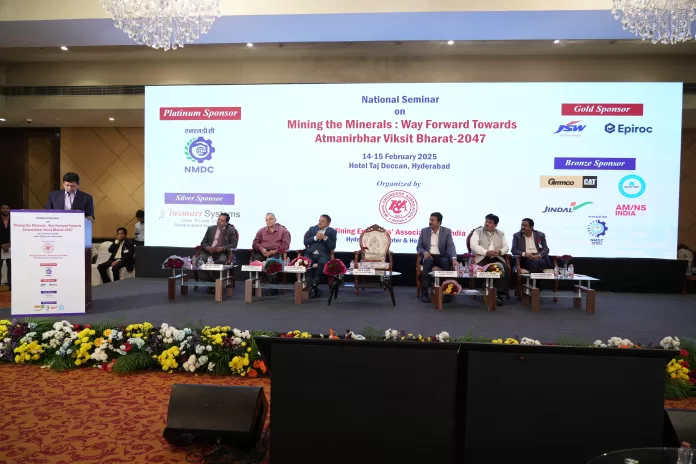The mining industry is an integral part of India’s economic development, playing a crucial role in industries ranging from construction to energy and technology. As India sets its sights on becoming a global leader in various sectors by 2047, the importance of sustainable mining practices cannot be overstated. The recent National Conference hosted by the Mining Engineers’ Association of India (MEAI) Hyderabad Chapter, titled ‘Mining the Minerals: Way Forward Towards Atmanirbhar Viksit Bharat 2047’, focused on critical issues facing the mining sector, aiming to chart a path toward a self-reliant and sustainable future for India.
Mining’s Role in India’s Growth
India’s mining sector has long been vital to the country’s infrastructure development and industrialization. Minerals such as coal, iron ore, bauxite, and limestone are essential to industries like steel production, energy generation, and infrastructure development. As the nation progresses toward becoming an Atmanirbhar Bharat (self-reliant India) and strives for a Viksit Bharat (developed India) by 2047, it is clear that mining will play a pivotal role in this transformation. The goal is to balance resource extraction with sustainability to ensure that India’s mineral wealth can continue to support economic development for generations to come.
Sustainable Mining Practices
One of the key discussions at the MEAI Hyderabad Chapter’s National Conference was the need to integrate sustainability into mining operations. Sustainable mining practices focus on minimizing environmental degradation, ensuring responsible resource extraction, and promoting the restoration of mined land. With global environmental concerns such as climate change and resource depletion gaining momentum, sustainable mining becomes imperative to reducing the sector’s carbon footprint.
Technologies such as automation, artificial intelligence (AI), and machine learning are rapidly changing the way mining is done. These innovations help optimize resource extraction processes, reducing waste, energy consumption, and carbon emissions. AI-powered systems can identify mining sites with the most valuable minerals while minimizing land disruption. Moreover, AI and automation improve the safety and efficiency of mining operations, which is crucial for both environmental protection and the well-being of workers.
Another important aspect of sustainability is the rehabilitation of mined lands. The restoration of ecosystems affected by mining activities is essential to reducing the long-term environmental impact. Advanced reclamation techniques, such as soil stabilization, reforestation, and water management practices, should be adopted across the sector.
Technological Innovation in Mining
Technological innovation is central to achieving sustainable mining. As discussed in the conference, the use of new technologies such as AI-driven mining, robotics, and machine learning can significantly improve mining efficiency. AI tools can analyze data from mines to optimize extraction processes, ensuring that mineral reserves are used in the most efficient manner possible.
Automation also plays a crucial role in reducing the environmental impact of mining. Automated machinery allows for the extraction of minerals with minimal human intervention, reducing risks to workers while improving productivity. Innovations in mineral processing, such as ammonia beneficiation for low-grade ores, can help unlock resources that were previously considered unprofitable or environmentally harmful to extract.
Policy Reforms for a Thriving Mining Sector
For the mining sector to achieve its full potential, India must implement effective policy reforms. The National Mineral Policy (NMP) has laid the groundwork for sustainable mining practices, but there is still much work to be done. Key areas for reform include simplifying the licensing process, improving transparency, and encouraging private sector investment. These changes would help streamline the regulatory framework, making it easier for companies to invest in mining operations while ensuring that environmental and social responsibilities are upheld.
Moreover, the policy should focus on encouraging the mining of critical and minor minerals, which are essential for the country’s growth in sectors such as electronics, renewable energy, and infrastructure. These minerals, including lithium, cobalt, and rare earth elements, are in high demand globally and are crucial for India’s green energy transition.
Developing a Skilled Workforce
As India moves toward becoming a global leader in mining, there is an urgent need to focus on workforce development. The sector must invest in skill development and training programs to equip the next generation of mining professionals with the expertise needed to navigate emerging technologies and global challenges.
The introduction of world-class training institutes will be crucial in preparing the workforce for the demands of modern mining. Partnerships with international organizations and the establishment of specialized programs can ensure that India’s mining workforce remains competitive in the global arena.
Strengthening Global Partnerships
India’s mining industry must also build stronger global partnerships to ensure the sustainable use of its mineral resources. As mineral demand increases globally, India must establish itself as a reliable supplier of both minerals and mining expertise. By strengthening international trade relations and encouraging foreign investment in the mining sector, India can enhance its access to global markets and secure the resources necessary for its economic development.
Moreover, these partnerships can help foster innovation and the transfer of technology, enabling India to adopt best practices in sustainable mining.
The mining sector in India is at a crossroads. As the nation aims for a Viksit Bharat by 2047, it must embrace sustainable practices, technological innovation, and policy reforms to ensure that its mineral resources are used responsibly. By focusing on sustainability, efficiency, and workforce development, India can become a global leader in mining while contributing to its long-term economic growth and environmental well-being.
The discussions held at the MEAI Hyderabad Chapter’s National Conference provided valuable insights into the future of the mining industry. As India continues its journey toward self-reliance and sustainable development, the mining sector must play a central role in shaping the nation’s future, ensuring that it thrives for generations to come.














